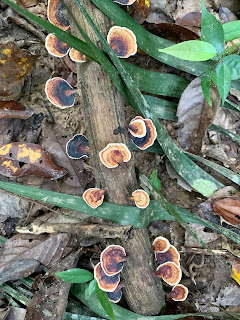Full trip map!
From Nusa Ceningan to our home in Denver, the return trip was a long and surreal journey through several different snapshots of the global pandemic. The first step was to get back to mainland Bali. Our hotel manager and his friend gave us a ride across the yellow bridge on the back of a scooter. From there, we caught a truck back out to the beach, where another speedboat took us the half hour back to Sanur. We still had a couple hours to kill before we needed to be at the airport, so we walked along the nearly empty beachfront looking for more trinkets to buy, but there wasn't anything of interest. So we just plunked down at a little restaurant by the beach, had a couple drinks, and bemoaned the situation with our waiter before getting a cab to the airport.
The airport was absolutely slammed. The line at the Singapore Airlines check-in counter extended well beyond the stanchions, wrapping almost all the way out of the terminal. Listening to people's conversations, we realized that many (even most) of them didn't have any tickets at all, and they had just showed up at the airport, desperate to pay whatever it took to get the soonest flight out of Bali. Someone told us that all flights for the next three days were completely booked. Fortunately, we already had tickets, and we joined the much shorter and quicker bag drop queue for people who had checked in online, and we made it through passport control and security with plenty of time to spare.
Our flight departed at about 9:45PM, and we arrived in Singapore just past midnight. We had about a nine-hour layover in Singapore, and we'd been hoping to pass through immigration and catch a few hours' sleep at a hotel on the airport grounds. Starting at midnight that night (about 15 minutes before we arrived), however, Singapore began imposing a mandatory 14-day shelter-in-place order to everyone entering the country, regardless of nationality or travel history. Thus trapped, we joined what seemed like thousands of other people scattered throughout the enormous terminal, sprawled on chairs or benches or the carpeted floor. We sought out the best floor space in the terminal that we could find, curled up, and got a few hours of fitful sleep.
So we were pretty dazed by the time our flight took off the following morning, bound for Seattle. Even though it was only about 11:00AM, Chandler zonked out and slept for about 7 hours of the 14-hour flight, while Michelle just watched movies the whole time. Even though the flight was only about 70% full, there was a slight atmosphere of tension in the air, as well as a couple small children who were continuously coughing in a wet, mucousy way that had us slightly on edge.
Compared to Singapore, the Seattle airport was completely dead. In a huge about-face from what we'd seen all over Asia, even going back to late January, the US Customs and Immigrations officials seemed to basically harbor no concern whatsoever about the virus. There were no temperature checks at all, our travel history was noted only very briefly, and the long health declaration forms we had filled out in Singapore before departing were completely ignored by everyone. This was all a little bit disconcerting, since we had been reading about all the shelter-in-place and self-quarantine measures being imposed on local and state levels.
In the terminal itself, we could see people making a halfhearted effort to practice a little social distancing, but it hardly mattered since the terminal was so empty anyways. We ate some delicious sandwiches (that were very expensive by our recent standards) and waited the couple hours til our flight left. This last plane was only about 20% full, and the vibe from the airline was nothing but effusive gratitude that we were there at all. We landed in chilly weather in Denver at about 4:00PM on the 21st, 10 days earlier than our original plan and 4 days before our first amended plan. On our way home from the airport, we chatted with our Uber driver, who said that even though demand for Ubers was way down, so was the supply of drivers, so he was still making out okay. Plus, everyone's ordering Uber Eats now, so that was a big plus.
We had agreed ahead of time with our roommate Craig that he would stay at his girlfriend's place while we self-quarantined for two weeks, so we came home to a very clean but sadly empty house. Since then, we've been spending our time catching up on small projects, watching movies, and going for walks, all the while reflecting on our amazing two and a half months in Asia, the weirdness with which it abruptly came to an end, and the strange new world to which we've returned.
Much love to everyone. Stay safe & thanks for reading.
Michelle & Chandler
Last beer in Asia (for now)
Nice souvenir from the Indonesian government
Madness at the Denpasar airport
Changi Airport, Singapore, 1:02AM
Home sweet home




















































